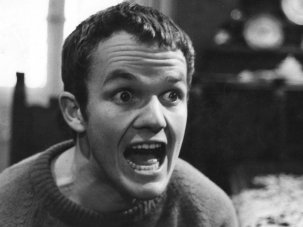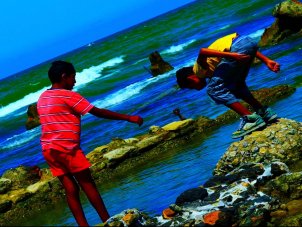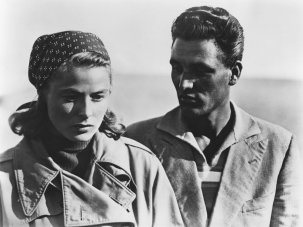Originally published as The Greatest Film-makers You’ve Never Heard Of in our December 2009 issue
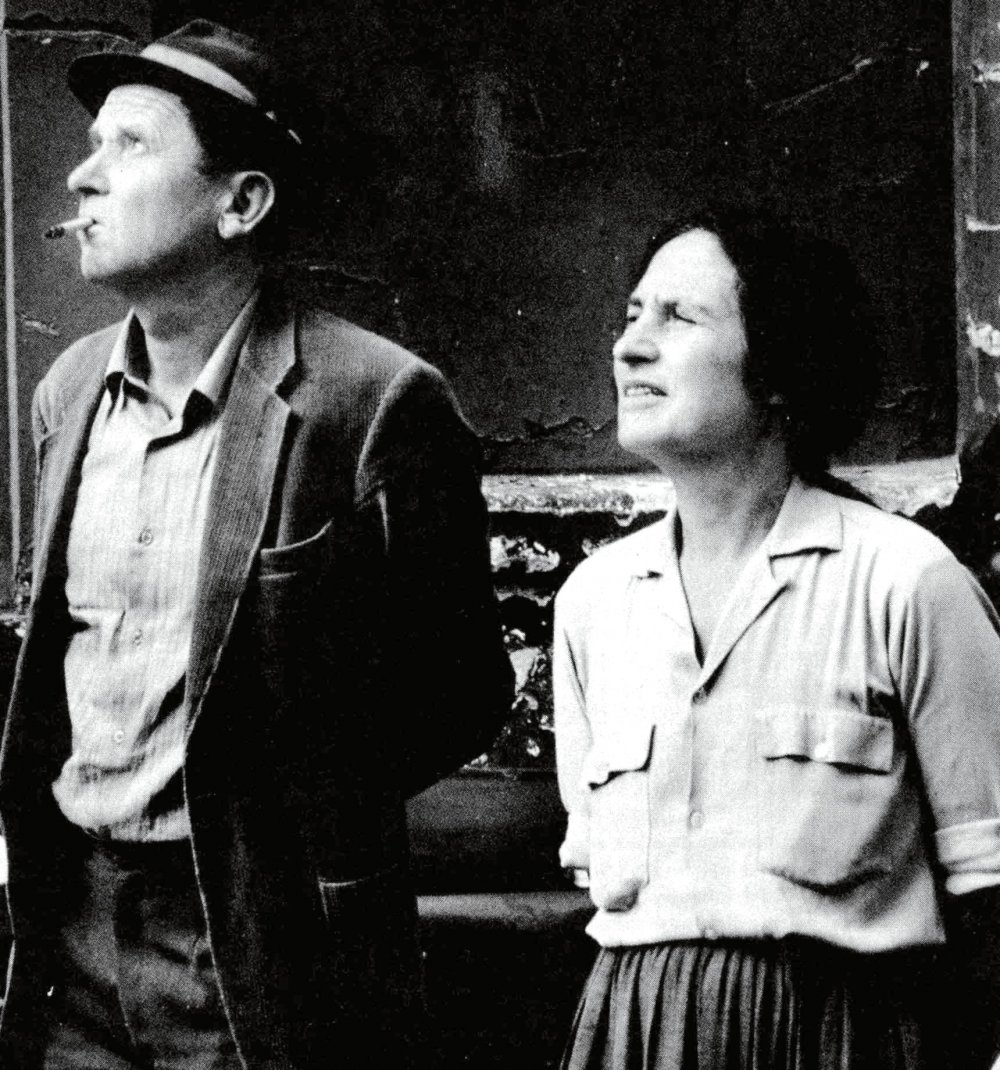
Jean-Marie Straub and Danièle Huillet
What’s wonderful about any Straub-Huillet movie is a style of performance that, real as only art can be, makes so many other movies seem tepid and stale. Once you turn on to it, the style is overpowering. It demands months of practice by the actors – a year and a half in the case of Der Tod des Empedokles (The Death of Empedocles), their 1986 adaptation of Hölderlin’s early 19th-century play. Then filming begins, with often a dozen takes of each shot – 48 for one on Sicilia! to find the right way for the grandfather to say, “Hee!”
A major retrospective, The Films of Jean-Marie Straub and Danièle Huillet, runs until June 2019 at the ICA Cinema, BFI Southbank, King’s College London, Birkbeck Cinema, Goethe-Institut London, Ciné Lumière, Close-Up and the Whitechapel Gallery. See also straub-huillet.com.
On DVD, Chronicle of Anna Magdalena Bach, Sicilia! and Une Visite au Louvre are available with English subtitles from New Wave Films; Class Relations aka Amerika with English and French subtitles from Editions Filmmuseum; and seven volumes of the pair’s films (without English subtitles) from Editions Montparnasse.
It’s to Robert Bresson that the Straubs are often likened, because of their stress on the mechanics of performance. But Bresson’s people are spirits miserably imprisoned in bodies, whereas the Straubs’ are proud exhibitionists, ‘show people’ like characters in Jean Renoir’s or John Ford’s pictures. And thus their words onscreen, no matter how trivial on paper, have substance, the intensity of life and its years. Suddenly movies matter.
Then somehow it doesn’t matter that, say, Cézanne is speaking with a woman’s voice (in their films Cézanne, 1989, and Une Visite au Louvre, 2004), or that the actors in Operai, contadini (Workers, peasants, 2000) are reading from scripts in their hands. They incarnate their characters the way your mother did when reading to you in bed. We believe in these people.
“Be at one with your body,” the Straubs tell their actors. And, putting their bodies into their lines, the actors are at one with the text. Are performers in other movies ever so physical? Does anyone else burst words so bodily as does Astrid Ofner in the Straubs’ Antigone (1991)?
Lothringen unbound
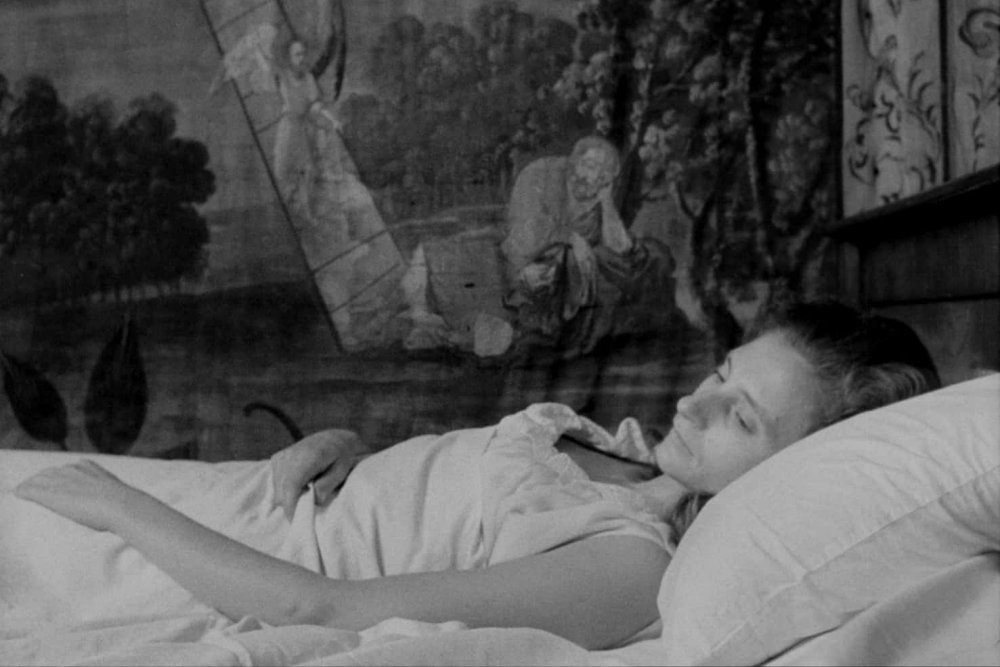
The Chronicle of Anna Magdalena Bach (1968)
When asked if ‘Straub’ is pronounced as in French or as in German, Jean-Marie Straub is apt to say he doesn’t know. Events recent and historic have made him a ‘Lothringen’. The city of Metz was French when he was born there in 1933, but seven years later it was captured by Germany (which had lost it in 1918 and 1552), whereupon he was permitted to speak only German at school – his affectionate short Lothringen! (1994) recounts a similar German conquest of Metz in 1870. Then in 1959, when he was 26 and Metz was again part of France, the French army wanted him to kill Algerians, so he fled to Germany and eventually to Italy.
Hence his life and the languages of his movies came to embrace the peoples of the Lotharingia of Carolingian times – French, German and Italian – as represented on New Wave Films’ double-disc DVD of their films Chronicle of Anna Magdalena Bach (Chronik der Anna Magdalena Bach, 1967), Sicilia! (1998) and Une Visite au Louvre.
Danièle Huillet was born in Paris in 1936 and met Straub in 1954 at the Lycée Voltaire, where they were preparing for the entrance exam to the prestigious film school IDHEC. They would be inseparable for 52 years, until her death in 2006. And neither went to the film school: Huillet refused to write a required essay on Yves Allégret’s 1949 melodrama Manèges, declaring the film not worth it. Straub left after arguing with an instructor about Hitchcock; instead, as one of the Cahiers crowd with Truffaut and Godard, he worked on films with Abel Gance, Renoir, Bresson, Alexandre Astruc and Jacques Rivette.
In 1959 Straub and Huillet married, moved to Munich and began a nine-year effort to make Chronicle of Anna Magdalena Bach. It would have taken less effort had they agreed to use Curd Jürgens instead of the classical musician Gustav Leonhardt as Johann Sebastian Bach, and had Herbert von Karajan dub the music. But throughout their career they would insist on being ‘artisanal’ movie-makers, controlling every aspect of their productions down to the subtitles on the prints. Thus the state subsidies granted to so many mediocre films were refused to them. Support for their work would come from a ‘happy few’ in television and museums.
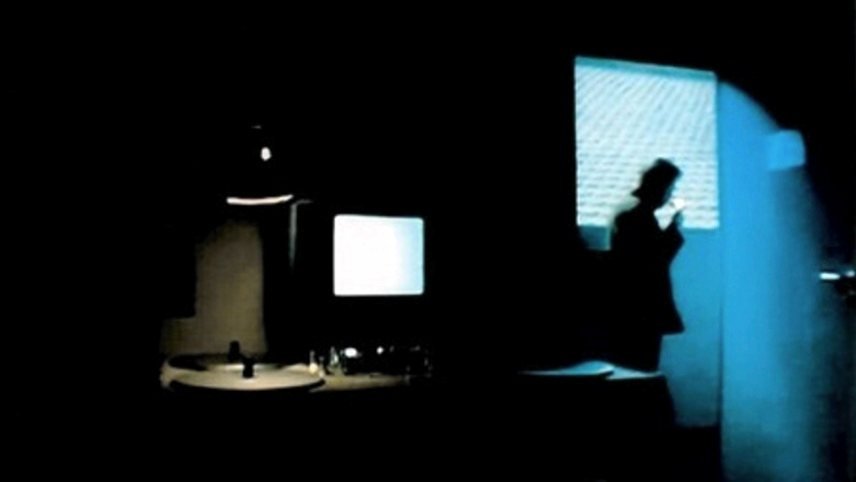
Where Does Your Hidden Smile Lie? (2001)
One of the best movies ever made about filmmaking, Pedro Costa’s wonderful Où gît votre sourire enfoui? (Where Lies Your Hidden Smile? (2001), available on a Portuguese DVD with English subtitles) is a portrait of their relationship and editing methods. In general, Straub found the images, while Huillet did the production chores; they both rehearsed the actors; then she did the post-production, but along with him – as one can see in Costa’s film.
For the Straubs, to have taken a conventional approach to Bach wouldn’t have been moral. They wanted Gustav Leonhardt and the spirit of the burgeoning period-instrument movement. And they wanted direct sound, in mono even, and the whole of a performance in one single shot, to capture its actuality. According to Straub, cinema is an art of time, not of space, and Bach’s music seizes hold of time, so to speak, and turns the nothingness of eternity into material. Hence Bach’s music expresses not simply his belief in an afterlife but also his defiance of death.
Originally, Huillet wanted to make ethnological documentaries. She spent years with Straub travelling everywhere Bach had been. All but one location had been altered, yet they microfilmed surviving contemporary documents that touched on Bach’s existence – on what remains, materially, of a man centuries after his death. Like Rossellini, Straub-Huillet recreate the past ethnologically, through the palimpsest of historic texts. We view Antigone as viewed by Sophocles as viewed by Hölderlin as viewed by Brecht as viewed by the Straubs as viewed by us – and our total belief in a 1990s Austrian as the Theban princess from mythic times is in no way diminished by the autostrada seen behind her.
In Othon (1969) we view Roman emperors as imagined by the 17th-century French dramatist Corneille; in Geschichtsunterricht (History Lessons, 1972) it’s Julius Caesar as seen by Brecht; in Der Tod des Empedokles and Schwarze Sünde (Black Sin, 1988) the pre-Socratic philosopher as seen by Hölderlin; in Moses und Aron (1974) rival conceptions of Israel by Schoenberg; in half a dozen of their films – Dalla nube alla resistenza (From the Clouds to the Resistance, 1978); Sicilia!; Operai, contadini (Workers, Peasants) and Umiliati (both 2003); MachorkaMuff (1962); and Nicht versöhnt (Not Reconciled, 1965) – it’s the continuity of fascism in postwar Italy and Germany today, as seen by the writers Cesare Pavese, Elio Vittorini and Heinrich Böll.
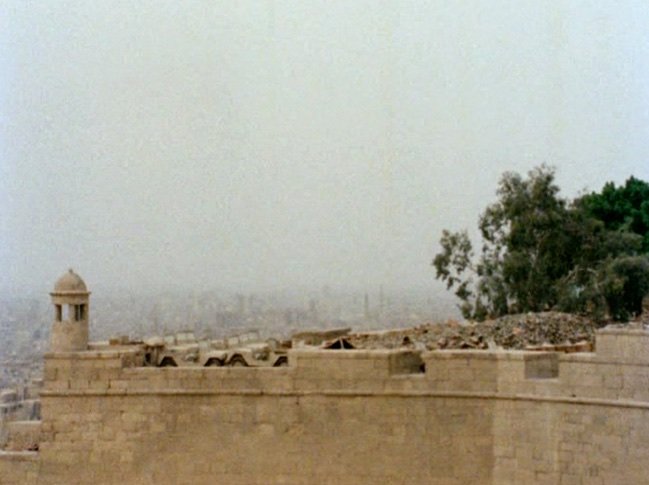
Too Early/Too Late (1982)
The palimpsest is physical as well. “There’s always a pool of blood somewhere that we’re walking in without knowing it,” says Straub. “There are always cadavers under a hill. It’s underneath Mont Sainte-Victoire that most of the dinosaurs in Europe were found. Under the butte of Père-Lachaise are the corpses of the Communards shot in 1871.” In Trop tôt, trop tard (Too Early, Too Late, 1982) we see village after village in France, all normal-looking, while Huillet gives us statistics of hundreds and thousands of massacred bodies lying beneath them. “There aren’t just bones underneath,” explains Straub. “There’s also the result of thousands of years. Thought is subject to the labours of the centuries.”
And it is precisely thought – this hummus of names that diminish what they name, that churn into spin – that Pavese’s mythological Tiresias derides as irrelevant in Dalla nube alla resistenza, in comparison to the ‘rock’ of noumenal reality. Ethnology seeks in myth the neglected histories of workers and farmers – of human sacrifice, as the Straubs recount in film after film. Humans call this or that a ‘god’ or a ‘law’, and amazingly people line up to sacrifice themselves, as if to the golden calf in Moses und Aron. We do it to ourselves but blame ‘necessity’. How else could we have wars?
Already in their first two movies, Machorka-Muff and Nicht versöhnt (both adapted from Heinrich Böll), the point is made that people of today are ‘no less bad’ than the Nazis – or, in subsequent movies, no less bad than the people of every age who burned humans alive. “It’s your blood that feeds the earth,” Straub insists. “It is you who fatten the servants of lies.” Yet there is precious little resistance. “Are there no knives left in the world?” laments the knife sharpener in Sicilia!
Out of the past
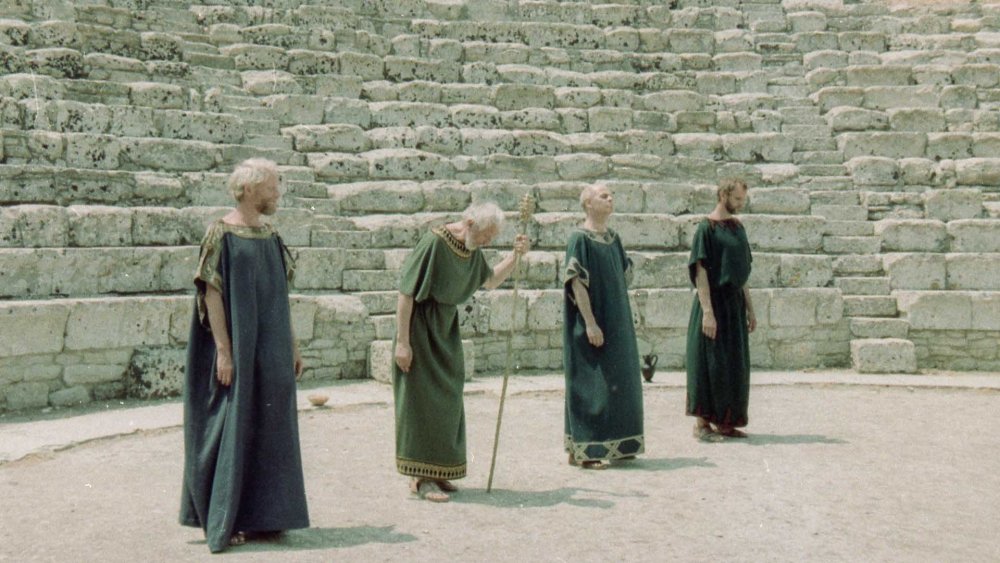
Antigone (1991)
Straub-Huillet didn’t have to change a word in Hölderlin’s Antigone for it to be an allegory of today. King Kreon comes questionably to power, attacks Argos to obtain iron, proclaims victory, desecrates sacred traditions and persecutes as terrorists anyone who criticises him. But it turns out everything has been lies, and the war has been lost.
Such obvious political targeting is rare in Straub-Huillet; with Antigone it was already there 3,000 years ago and the film was shot in 1991, 12 years before the occupation of Iraq. Their movies question not today, but the past; not the past but individual experiences which characters relive in soaring arias, so that their experiences happen right now for us to relive with them. Often we relive joy; often we relive the lacrimae rerum that ‘offend the world’. The movies target life at its most primal.
Straub in his own voice, however, is famously forthright. For example, in 2006 Straub-Huillet were given a Special Lion by the Venice Film Festival. “It comes too soon for our death – too late for our life,” Straub remarked.
Indeed, for a quarter of a century they had been arguably among the world’s greatest filmmakers and this was their first major award. Straub apologised for not being able to attend – and added, “Besides, I couldn’t have a good time at a festival where there are so many public and private police looking for a terrorist – the terrorist is me, and I tell you, paraphrasing Franco Fortini: as long as there’s American imperialist capitalism, there won’t be enough terrorists in the world.”
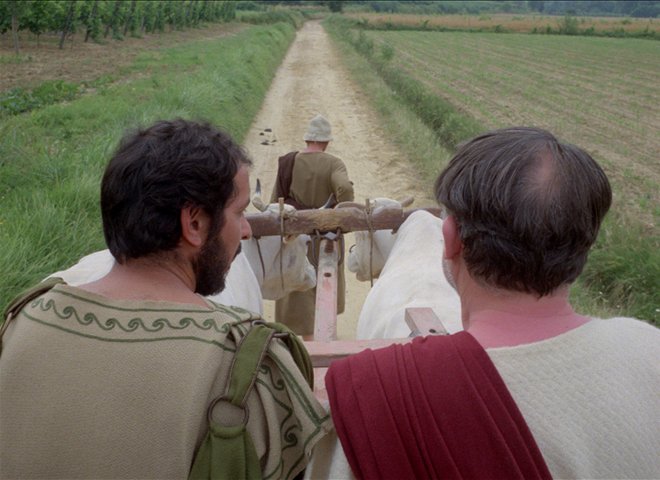
Dalla nube alla resistenza (From the Clouds to the Resistance, 1978)
Straub’s genius is that he makes images richer than words, richer than names. Tiresias’ monologue in Dalla nube alla resistenza, for example – about how the ‘rock’ constantly defeats our attempt to name it – is portrayed in an image which defeats our sight (because we can’t focus simultaneously on its three planes, nor absorb everything along the endless road).
And yet despite Tiresias’ view, the Straubs’ movies are unfaltering in their conviction that individual consciousness transcends even the unnameable ‘rock’. How could they not be, since at their heart is the consciousness of reliving an event? The individual is more vivid than the rock. The Straubs’ characters, as their former assistant Jean-Charles Fitoussi exclaims, are “magnificent, every one of them, and each with a manner so singular that discovering them one after another is like assisting each time at the birth of a new world”.
So if on one hand our insistence on giving names to things results in a meta-reality that, like the Krells’ machines in Forbidden Planet, ends up incinerating us, on the other hand there is the wondrous intensity of mortality. Even Pavese’s gods in Dialogues with Leucò – his retellings of Greek legends filmed by the Straubs in Dalla nube alla resistenza and Quei loro incontri (2006), and by Straub alone in the recent shorts Le Genou d’Artémide (2008) and Le streghe, femmes entre elles (2009) – yearn for the vividness of mortality. They seek sex with mortals, and materialise themselves as streams and trees and mountains and volcanoes. “Once it was fire,” as Cézanne exclaims of Mont Sainte-Victoire in their 1989 film about the artist.
Bach too, like Cézanne, sacrifices his life to a vision. At the end of Chronicle of Anna Magdalena Bach he goes blind and gazes sightlessly out of the window, like so many Straub characters who must yearn for the horizon. Does he see God, or a void, or just trees? Does he see answers or questions? Is he looking outward or inward?
Beyond language
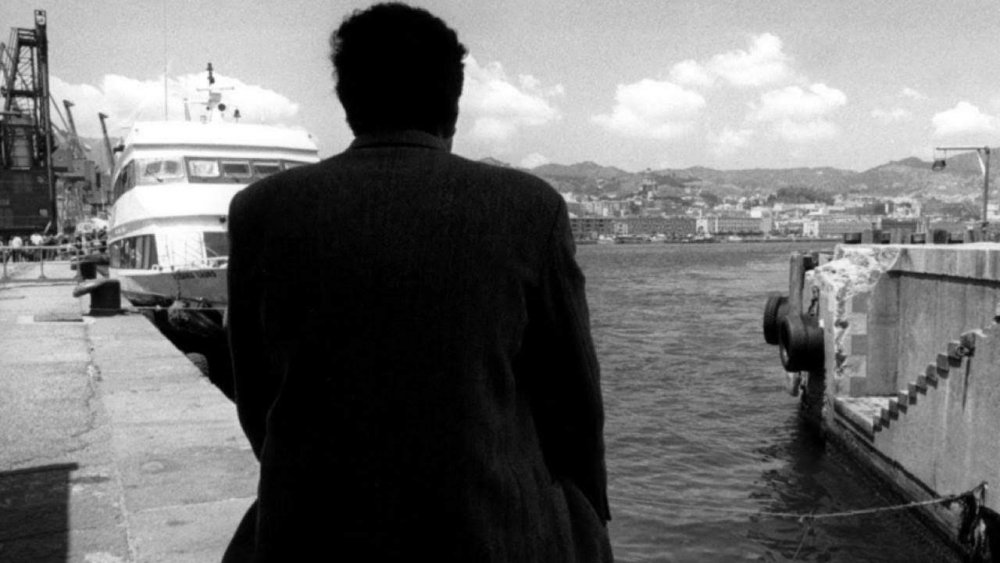
Sicilia! (1998)
In contrast to John Ford, who typically places his characters in the middle of three planes of depth, thus within their culture, the Straubs place their people on the scenery, like the mother in Sicilia! gazing out beyond the horizon of the frame, abstracted from material context and yet part of it. She stares like the people in every Straub-Huillet movie. Sometimes, as with Silvestro in Sicilia!, the character is a proscenium, existentially apart from the world but peering in – a drama of hubris which starts in Sicilia!’s first shot, where Silvestro’s silhouetted back dominates the foreground, and which climaxes in the last shot, in his conversation with the knife sharpener, where a wide-angle lens amplifies his self-imposed apartness.
The texts of Straub-Huillet movies are important – and often difficult, concentrated, poetic, philosophic, personable and beautiful, as great literature can be – and well worth our effort. The Straubs’ craft is to turn texts into intonation and rhythm on one hand, and into images on the other. “I don’t take myself for Cézanne,” Straub has said, “but if you look at a Cézanne canvas, it doesn’t provoke sensations in you – you see there sensations materialised.” Thus the Straubs’ craft is finally to make the texts themselves disappear, whereupon we have a movie – which is why the words have so much more substance.
We have a movie, that is, unless our experience of a Straub-Huillet film is dominated by frenetic efforts to grasp the subtitles. Yes, we may manage partially to recuperate the text – in a language we may not readily understand – but in trying to extract the text from the film, we shall likely miss everything wonderful in the movie.
There may even be advantages in not understanding a foreign language. German Lieder are one of life’s great pleasures, even if we don’t understand German and pay no attention to the words. At least that way we get direct access to melody and rhythm, voice colour, emotions, and to the person speaking to us – a kind of sacred magic.
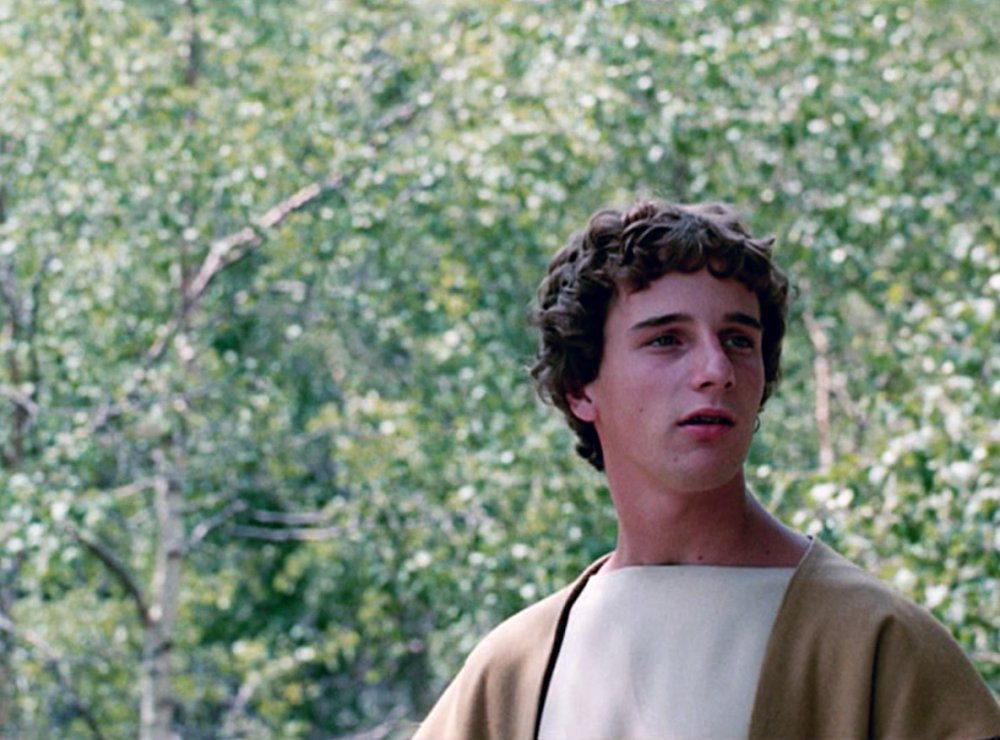
The Death of Empedocles (1986)
Comparison to Lieder is appropriate, because in the Straubs’ movies everyone ‘sings’ all the time; their months of rehearsal of intonation and rhythm are just like piano practice. They treat verse like verse, marking meter and pausing at the end of lines. And they were virtually the only filmmakers in Italy who used direct sound. The objection that so much rehearsal kills spontaneity is for the Straubs as silly as a musician refusing to practise. “Liberty is conquered only through mechanics,” says Straub.
It is possible to sit enchanted through Der Tod des Empedokles without the slightest idea what Hölderlin’s words mean. The Straubs put flesh to Hölderlin, supersede his words, and create melodrama. What we face is humour, emotion, passion, raw beauty, revelation – souls whose existence, because it is momentary, is defiance. And thus there is plot galore.
“We want people to lose themselves in our films,” Straub has said. “All this talk about ‘distanciation’ is bullshit. What I want to do is a combination of Ford and Mizoguchi.” How curious, then, that some critics define Straub-Huillet as ‘minimalist’. Perhaps they have fetishes for subtitles, for clearly it’s ‘maximalism’ they should be trumpeting. As Cézanne says: “The immensity, the torrent of the world in a tiny piece of material.”
-
The Digital Edition and Archive quick link
Log in here to your digital edition and archive subscription, take a look at the packages on offer and buy a subscription.




